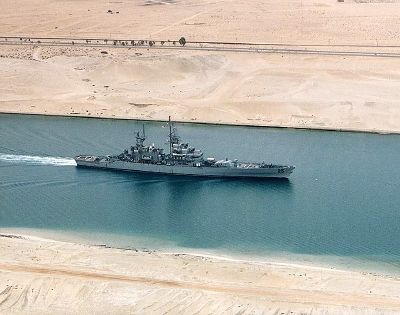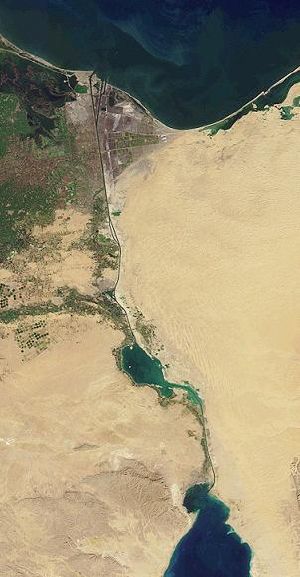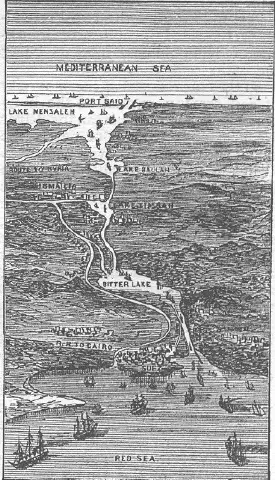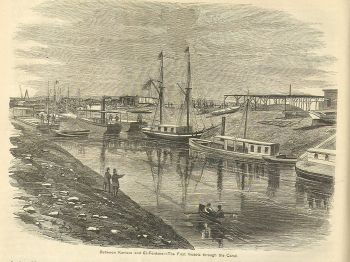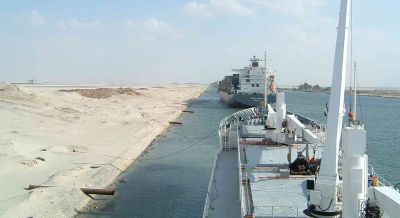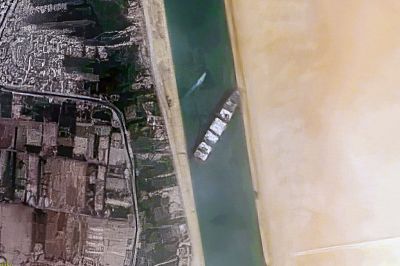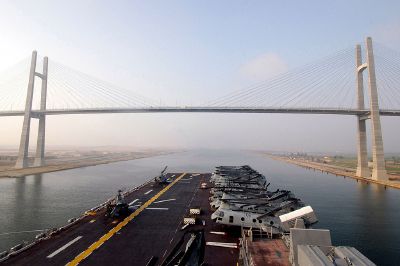Suez Canal
The Suez Canal (Arabic: قناة السويس, Qanā al-Suways), is a large, artificial maritime canal in Egypt west of the Sinai Peninsula. It is 101 miles long and 984 feet wide at its narrowest point, running between Port Said on the Mediterranean Sea, and Suez (al-Suways) on the far northern shore of the Red Sea.
The canal allows two-way water transportation between Europe and Asia without circumnavigation of Africa. Before its opening in 1869, goods were sometimes offloaded from ships and carried over land between the Mediterranean and the Red Sea. The canal comprises two parts, north and south of the Great Bitter Lake, linking the Mediterranean Sea to the Gulf of Suez on the Red Sea.
If the Nile River is the "lifeblood of Egypt," then the Suez Canal is the Egypt's umbilical cord to the world. Some 7.5 percent of the world's sea trade travels the canal, as does most of Europe's oil. This strategic waterway has existed almost as long as Egyptian civilization, with digging going back to the pharaohs, followed by the Persians, and Ptolemy; even Napoleon saw its value. Many thousands were said to have died during its construction. Always a geopolitical flashpoint, international conflicts broke out at the canal in the 1950s and 1960s. Today, the Suez Canal remains a key short-cut for circumnavigation of the world.
History
The ancient west-east canal
Perhaps as early as the Twelfth Dynasty during the reign of Pharaoh Senusret III (1878 B.C.E. – 1839 B.C.E.), a west-east canal connecting the Red Sea to the Wadi Tumilat had been created. This early canal connected the sea to the easternmost of the seven arms of the Nile—thus allowing trade indirectly from the Mediterranean. Evidence indicates its certain existence by the thirteenth century B.C.E. during the time of Ramesses II.[1]
The west-east canal later fell into disrepair and according to the Greek historian Herodotus, Pharaoh Necho II undertook re-excavation about 600 B.C.E., but did not complete it. Repairs were finally completed by Darius I of Persia, who conquered Egypt. According to Herodotus, the completed canal was wide enough that two triremes could pass each other with oars extended, and required four days to traverse. Darius commemorated his achievement with a number of granite stelae that he set up on the Nile bank, including one near Kabret, 130 miles from Pie. One inscription reads:
Saith King Darius: "I am a Persian. Setting out from Persia, I conquered Egypt. I ordered this canal dug from the river called the Nile that flows in Egypt, to the sea that begins in Persia. When the canal had been dug as I ordered, ships went from Egypt through this canal to Persia, even as I intended."[2]
The west-east canal was again restored by Ptolemy II about 250 B.C.E. Over the next thousand years it was successively modified, destroyed, and rebuilt, until finally being put out of commission in the eighth century C.E. by the Abbasid caliph al-Mansur.
Napoleon's plan
At the end of the eighteenth century C.E., Napoleon Bonaparte, while in Egypt, contemplated the construction of a canal to join the Mediterranean and Red Seas, using the basic route of the current canal. But this project was abandoned after a survey erroneously concluded that the Red Sea was 32.8 feet higher than the Mediterranean. This would require constructing a giant, locks-based canal and was much too expensive and would take too long to accomplish.
The Suez Canal Company
In 1854 and 1856, Ferdinand de Lesseps, a former French diplomat with friendly connections with Egyptian authorities, obtained a concession from Said Pasha, the Ottoman viceroy of Egypt, to create a company to construct a maritime canal open to ships of all nations, according to plans created by Austrian engineer Alois Negrelli. The company was to operate the canal by leasing the relevant land for 99 years from its opening, for navigation purposes only. The Suez Canal Company came into being on December 15, 1858.
The excavation took nearly 11 years, mostly through the forced labor of Egyptian workers—a form of labor which was not unique to the French, nor the British before them. Some sources estimate that over 30,000 people were forced to work on the canal, while others estimate that as many 120,000 people, both forced and hired laborers, died from the work.[3]
Labor controversy
The British recognized the canal as an important trade route and perceived the French project as a direct menace to their geopolitical and financial interests. The British Empire was the major global naval force of this era, and its power had increased during the American Civil War. The British government officially condemned the forced labor and encouraged armed bedouins to start a revolt among workers. Involuntary labor on the project ceased, the viceroy soon condemned it as slavery, and the project was temporarily stopped.[4]
Angered by this intervention, de Lesseps sent a letter to the British government remarking on the British lack of remorse only a few years earlier when 80,000 Egyptian forced workers allegedly died in similar conditions while building a British railroad in Egypt.
At first, international opinion about the project was skeptical, and the Suez Canal Company shares did not sell well overseas. Britain, the United States, Austria, and Russia did not buy any shares. However, shares were quickly purchased in French markets.
The canal opens
The canal finally opened to traffic on November 17, 1869. Although numerous technical, political, and financial problems had been overcome, the final cost was more than double the original estimate.
The canal had an immediate and dramatic effect on world trade. Combined with the American transcontinental railroad completed six months earlier, it allowed the entire world to be circled in record time. It also played an important role in increasing European penetration and colonization of Africa. External debts forced Said Pasha's successor, Isma'il Pasha, to sell his country's share in the canal for $8 million to the United Kingdom in 1875. France, however, still remained the majority shareholder.
British control
British troops moved in to protect the canal during a civil war in Egypt in 1882, and the Convention of Constantinople in 1888 declared the canal a neutral zone under the protection of the United Kingdom. Under the Anglo-Egyptian Treaty of 1936, the UK insisted on retaining control over the canal. However, after World War II, in 1951, Egypt repudiated the treaty, and by 1954 the UK had agreed to pull out.
Suez Crisis
Egyptian President Gamal Abdel Nasser nationalized the canal in 1956, after the UK and the United States withdrew their pledge to support the construction of the Aswan Dam. Nasser intended to finance the dam project using revenue from the canal. This provoked the week-long Suez Crisis, in which the UK, France, and Israel joined forces to invade Egypt. The threat of intervention on behalf of Egypt by the Soviet Union and pressure from Lester B. Pearson, then the prime minister of Canada, ended the crisis. For this, Pearson won the Nobel Peace Prize.
As a result of damage and sunken ships, the canal was closed until April 1957, when it had been cleared with United Nations assistance. A UN force (UNEF) was established to maintain the neutrality of the canal and the Sinai Peninsula.
Arab-Israeli War of 1967
The Suez Canal was closed by the 1967 Six-Day War when Israel victoriously fought [Egypt]], Syria, Jordan, and various Palestinianfactions. After the war, Israel declared that it would not give up Jerusalem and that it would hold other captured territories until significant progress had been made in Arab-Israeli relations. The end of active, conventional fighting was followed by frequent artillery duels along the frontiers and by clashes between Israelis and Palestinian guerrillas, which kept the Suez Canal closed.
In 1973, during the Yom Kippur War, the canal was the scene of a major crossing by the Egyptian army into Israeli-occupied Sinai. After this war, Egyptian and Syrian diplomatic relations with the United States, broken since the 1967 war, were resumed and the clearance of the Suez Canal began. The canal was finally opened again on June 5, 1975.
UN presence
The UNEF mandate expired in 1979. Despite the efforts of the United States, Israel, Egypt, and others to obtain an extension of the UN role in observing the peace between Israel and Egypt, as called for under the Egypt–Israel Peace Treaty of 1979, the mandate could not be extended because of the veto by the Soviet Union in the UN Security Council, at the request of Syria. Accordingly, negotiations for a new observer force in the Sinai produced the Multinational Force and Observers (MFO), stationed in Sinai in 1981 in coordination with a phased Israeli withdrawal. The MFO remains active under agreements between the United States, Israel, Egypt, and other nations.[5]
Bypass expansion
In the summer of 2014, months after taking office as President of Egypt, Abdel Fattah el-Sisi ordered the expansion of the Ballah Bypass from 61 meters (200 ft) wide to 312 meters (1,020 ft) wide for 35 kilometers (22 mi). The project was called the New Suez Canal, as it allows ships to transit the canal in both directions simultaneously.[6] The project cost more than E£59.4 billion (US$9bn) and was completed within one year. Sisi declared the expanded channel open for business in a ceremony on August 6, 2015.[7]
Operation
The canal has no locks because the terrain through which it passes is flat. Despite calculations made during Napoleon's time, the sea level at both ends is virtually the same. The canal allows the passage of ships of up to some 150,000 tons displacement, with cargo. It permits ships of up to 53 feet draft to pass, and improvements are planned to increase this to 72 feet by 2010 to allow supertanker passage. Presently, supertankers, weighing 200,000 dead weight tons and more, can offload part of their cargo onto a canal-owned boat and reload it onto a smaller tanker at the other end of the canal. These smaller tankers can offload their fuel at numerous ports around the world, unlike the supertanker, which has a limited number of facilities able to accommodate them.
On a typical day, three convoys transit the canal, two southbound and one northbound. The first southbound convoy enters the canal in the early morning hours and proceeds to the Great Bitter Lake, where the ships anchor out of the fairway and await the passage of the northbound convoy. The northbound convoy passes the second southbound convoy, which moors to the canal bank in a by-pass, in the vicinity of El Qantara. The passage takes between 11 and 16 hours at a speed of around eight knots. The low speed helps prevent erosion of the canal banks by ship's wakes.
Egypt's Suez Canal Authority (SCA) reported in 2003 that 17,224 ships passed through the canal. By 1955 approximately two-thirds of Europe's oil passed through the canal. About 7.5 percent of world sea trade is carried via the canal today. Receipts from the canal July 2005 to May 2006 totaled $3.246 billion. In 2005, 18,193 vessels passed through the canal.[3]
New Rules of Navigation came into force on January 1, 2008, passed by the board of directors of the Suez Canal Authority (SCA) to organize vessels' transit. The most important amendments include allowing vessels with 62-foot (19 m) draught to pass, increasing the allowed breadth from 32 meters (105 ft) to 40 meters (130 ft) (following improvement operations), and imposing a fine on vessels using pilots from outside the SCA inside the canal boundaries without permission. The amendments allow vessels loaded with dangerous cargo (such as radioactive or flammable materials) to pass if they conform with the latest amendments provided by international conventions. The SCA has the right to determine the number of tugs required to assist warships traversing the canal, to achieve the highest degree of safety during transit.
On March 23, 2021, the Suez Canal was blocked in both directions by the ultra-large Golden-class container ship Ever Given. The ship, operated by Evergreen Marine, was en route from Malaysia to the Netherlands when it ran aground after strong winds allegedly blew the ship off course.[8] Upon running aground, Ever Given turned sideways, completely blocking the canal.[9] Although part of the length of the canal is paralleled by an older narrower channel which can still be used to bypass obstructions, this particular incident happened in a section of the canal with only one channel.[10] The ship was re-floated on 29 March. Within a few hours, cargo traffic resumed, slowly resolving the backlog of around 450 ships.[11]
Connections between the shores
Listed from north to south, connections across the canal are:
- The Suez Canal Bridge, also called the Egyptian-Japanese Friendship Bridge, is a high-level, fixed-road bridge at El Qantara. It has a 230-foot clearance over the canal and was built with assistance from the Japanese government.
- El Ferdan Railway Bridge 12.42 miles north of Ismailia was completed in 2001 and is the longest swing span bridge in the world, with a span of 1100 feet. The previous bridge was destroyed in 1967 during the Arab-Israeli conflict.
- Ahmed Hamdi Tunnel south of the Great Bitter Lake was built in 1983. Because of leakage problems, a new water-tight tunnel was built inside the old one, from 1992 to 1995.
- The Suez Canal overhead line crossing power line was built in 1999.
A railway on the west bank runs parallel to the canal for its entire length.
Timeline
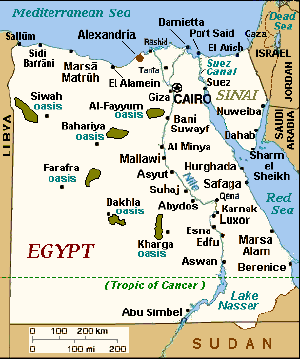
- c. 1799 — Napoleon I of France conquered Egypt and ordered a feasibility analysis, which reported a supposed 32.8-foot difference in sea levels. Because of high estimated costs, the project was set on standby.
- c. 1840 — A second survey demonstrated nearly identical sea levels at both ends of the proposed canal, meaning that a direct link between the Mediterranean Sea and the Red Sea would be possible and would not be as expensive as expected.
- c. 1854 — The French consul in Cairo, Ferdinand Marie de Lesseps, created the "Compagnie Universelle du Canal Maritime de Suez."
- April 25, 1859 — The French were officially allowed to begin the canal construction (Said Pacha acquired 22 percent of the Suez Canal Company, the rest of the shares were controlled by French private holders).
- November 16, 1869 — The Suez Canal opened; operated and owned by the Suez Canal Company.
- November 25, 1875 — Britain became a minority shareholder, acquiring 44 percent of the Suez Canal Company. The rest of the shares were controlled by French syndicates.
- August 25, 1882 — Britain took control of the canal.
- March 2, 1888 — The Convention of Constantinople guaranteed the right of passage of all ships through the Suez Canal during war and peace.
- November 14, 1936 — Suez Canal Zone established, under British control.
- June 13, 1956 — Canal Zone restored to Egypt.
- July 26, 1956 — Egypt nationalized the Canal.
- November 5-22, 1956 — French, British, and Israeli forces occupied the Suez Canal Zone.
- December 22, 1956 — Canal was restored to Egypt.
- June 5, 1967 to June 5, 1975 — Canal closed and blockaded by Egypt.
- June 5, 1975 — Canal reopened.
- January 1, 2008 — New rules of navigation passed by the Suez Canal Authority come into force.
- August 6, 2015 — The new canal extensions are opened.
Notes
- ↑ S. Rappaport, Chapter V: The Water Ways of Egypt History of Egypt (London: The Grolier Society). Retrieved April 7, 2021.
- ↑ Jona Lendering, Darius' Suez Inscriptions Livius.org. Retrieved April 7, 2021.
- ↑ 3.0 3.1 The Suez Crisis: Key maps BBC News, July 21, 2006. Retrieved April 7, 2021.
- ↑ Uwe Oster, Le canal de Suez Arte, August 10, 2006. Retrieved April 7, 2021.
- ↑ Multinational Force and Observers Retrieved April 7, 2021.
- ↑ Aiswarya Lakshmi, Egypt Completes New Waterway in Suez Canal Marine Link, July 17, 2015. Retrieved April 7, 2021.
- ↑ Eric Knecht, Egypt's Sisi launches nationalist New Suez Canal celebration Reuters, August 6, 2015. Retrieved April 7, 2021.
- ↑ Egypt's Suez Canal blocked by huge container ship BBC News, March 24, 2021. Retrieved April 7, 2021.
- ↑ Jon Gambrell and Samy Magdy, Massive cargo ship becomes wedged, blocks Egypt’s Suez Canal Associated Press, March 24, 2021. Retrieved April 7, 2021.
- ↑ Salma El Wardany, Mirette Magdy, Jack Wittels, and Ann Koh, Suez Canal Stays Blocked Despite Efforts to Free Stuck Ship Bloomberg, March 24, 2021. Retrieved April 7, 2021.
- ↑ With the Suez Canal Unblocked, the World’s Commerce Resumes Its Course The New York Times, March 30, 2021. Retrieved April 7, 2021.
ReferencesISBN links support NWE through referral fees
- Burchell, S. C. Building the Suez Canal. HarperCollins, 1966. ISBN 978-0060209162
- Karabell, Zachary. Parting the Desert: The Creation of the Suez Canal. Vintage, 2004. ISBN 978-0375708121
- Schonfield, Hugh Joseph. The Suez Canal in World Affairs. Literary Licensing, LLC, 2013 (original 1953). ISBN 978-1258957735
- Stewart, Gail. Building History-The Suez Canal. Lucent Books, 2001. ISBN 978-1560068426
- Varble, Derek. The Suez Crisis 1956. Osprey Publishing, 2003. ISBN 978-1841764184
External links
All links retrieved February 26, 2023.
Credits
New World Encyclopedia writers and editors rewrote and completed the Wikipedia article in accordance with New World Encyclopedia standards. This article abides by terms of the Creative Commons CC-by-sa 3.0 License (CC-by-sa), which may be used and disseminated with proper attribution. Credit is due under the terms of this license that can reference both the New World Encyclopedia contributors and the selfless volunteer contributors of the Wikimedia Foundation. To cite this article click here for a list of acceptable citing formats.The history of earlier contributions by wikipedians is accessible to researchers here:
The history of this article since it was imported to New World Encyclopedia:
Note: Some restrictions may apply to use of individual images which are separately licensed.
